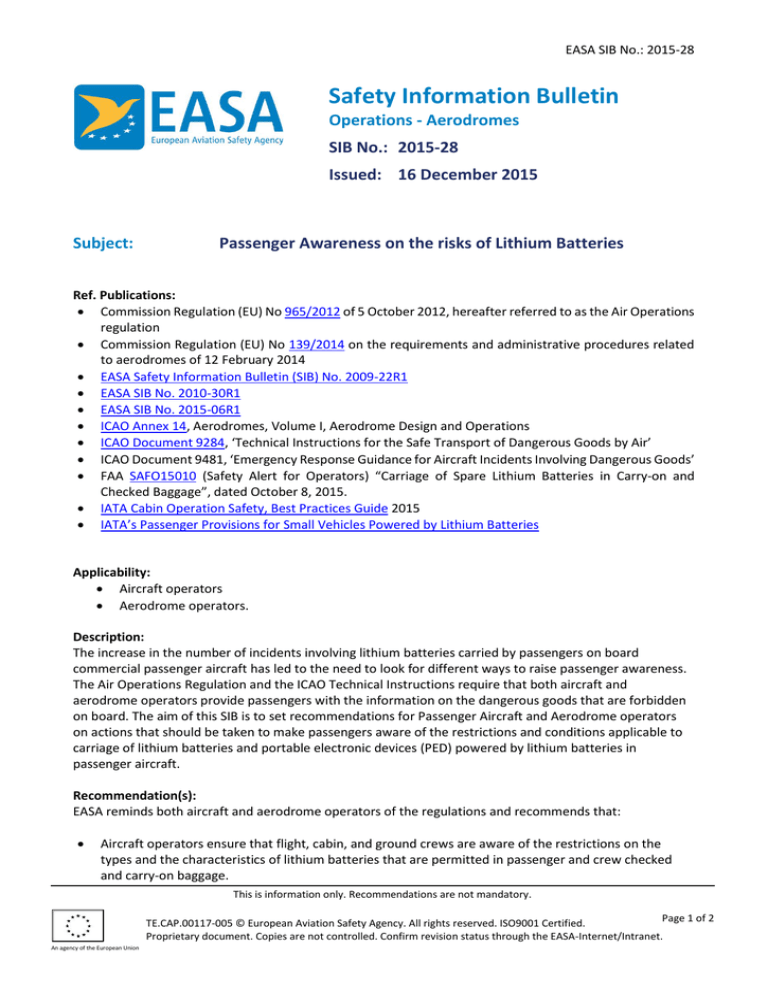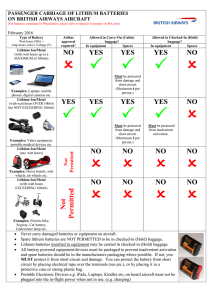
EASA SIB No.: 2015-28
Safety Information Bulletin
Operations - Aerodromes
SIB No.: 2015-28
Issued: 16 December 2015
Subject:
Passenger Awareness on the risks of Lithium Batteries
Ref. Publications:
Commission Regulation (EU) No 965/2012 of 5 October 2012, hereafter referred to as the Air Operations
regulation
Commission Regulation (EU) No 139/2014 on the requirements and administrative procedures related
to aerodromes of 12 February 2014
EASA Safety Information Bulletin (SIB) No. 2009-22R1
EASA SIB No. 2010-30R1
EASA SIB No. 2015-06R1
ICAO Annex 14, Aerodromes, Volume I, Aerodrome Design and Operations
ICAO Document 9284, ‘Technical Instructions for the Safe Transport of Dangerous Goods by Air’
ICAO Document 9481, ‘Emergency Response Guidance for Aircraft Incidents Involving Dangerous Goods’
FAA SAFO15010 (Safety Alert for Operators) “Carriage of Spare Lithium Batteries in Carry-on and
Checked Baggage”, dated October 8, 2015.
IATA Cabin Operation Safety, Best Practices Guide 2015
IATA’s Passenger Provisions for Small Vehicles Powered by Lithium Batteries
Applicability:
Aircraft operators
Aerodrome operators.
Description:
The increase in the number of incidents involving lithium batteries carried by passengers on board
commercial passenger aircraft has led to the need to look for different ways to raise passenger awareness.
The Air Operations Regulation and the ICAO Technical Instructions require that both aircraft and
aerodrome operators provide passengers with the information on the dangerous goods that are forbidden
on board. The aim of this SIB is to set recommendations for Passenger Aircraft and Aerodrome operators
on actions that should be taken to make passengers aware of the restrictions and conditions applicable to
carriage of lithium batteries and portable electronic devices (PED) powered by lithium batteries in
passenger aircraft.
Recommendation(s):
EASA reminds both aircraft and aerodrome operators of the regulations and recommends that:
Aircraft operators ensure that flight, cabin, and ground crews are aware of the restrictions on the
types and the characteristics of lithium batteries that are permitted in passenger and crew checked
and carry-on baggage.
This is information only. Recommendations are not mandatory.
Page 1 of 2
TE.CAP.00117-005 © European Aviation Safety Agency. All rights reserved. ISO9001 Certified.
Proprietary document. Copies are not controlled. Confirm revision status through the EASA-Internet/Intranet.
An agency of the European Union
EASA SIB No.: 2015-28
Aircraft operators communicate these restrictions to passengers at the time of check-in. This process
shall also include an acknowledgement by the passenger of this information. This may be done by
displaying, among others, visual examples of lithium batteries.
Both aircraft and aerodrome operators, assisted by ground handling agents, develop means to make
passengers aware of risks associated with lithium batteries and equipment powered by them, and the
restrictions applied to their carriage. This information shall include:
o the requirement that all spare lithium batteries must be in carry-on baggage and protected
against short circuit;
o that equipment with lithium batteries installed is protected against damage and unintentional
activation; and
o the limitation in watt hours (Wh) for electrical powered equipment that is carried on board by
passengers. The maximum rate for electrical powered devices is 100 Wh and, with the operator’s
approval, 160 Wh.
Aircraft operators ensure that all personnel are aware that spare lithium batteries are not permitted in
checked baggage. In addition, aircraft operators should ensure that passengers remove lithium
batteries from their carry-on baggage where such baggage cannot be accommodated in the cabin. In
these cases where the baggage is removed from the passenger at the gate, aircraft operators should
ensure that the information on the items that cannot be placed in checked baggage is provided to the
passengers again at this point.
Aircraft operators ensure that all crew members are trained and aware of the characteristics of the
lithium battery fires and fully understand and know the procedures established by the operator to
extinguish such fires.
Aircraft and aerodrome operators make passengers aware of the risks caused by PED as a result of the
battery being potentially short-circuited or damaged if caught in the movable part of seats, and that
they should call a staff member when such situation occurs and/or whenever any abnormal situation is
suspected, either on board the aircraft, or at the aerodrome.
Aerodrome operators ensure that Rescue and Fire Fighting Services personnel are fully aware of the
characteristics of the lithium battery fires and that their training includes the specifics of how to
properly respond to such emergency situations.
Aircraft and aerodrome operators ensure the reporting of any occurrence related to lithium batteries
to the appropriate authorities, in accordance with the applicable requirements.
Aircraft operators additionally take into account the recommended actions as given in the FAA SAFO
referred above.
Contact(s):
For further information contact the EASA Safety Information Section, Certification Directorate.
E-mail: ADs@easa.europa.eu.
This is information only. Recommendations are not mandatory.
Page 2 of 2
TE.CAP.00117-005 © European Aviation Safety Agency. All rights reserved. ISO9001 Certified.
Proprietary document. Copies are not controlled. Confirm revision status through the EASA-Internet/Intranet.
An agency of the European Union





